The ASRock Rack TRX40D8-2N2T is something truly innovative. The ATX form factor board eschews conventional gaming ornamentation common of its AMD Ryzen Threadripper motherboard contemporaries. Instead, ASRock rack continues in the theme of its ASRock Rack X570D4I-2T and builds a server-focused platform around a high-performance AMD Threadripper chip. The result is surprisingly good for what it hopes to accomplish, a marriage of the best of the workstation with server features.
ASRock Rack TRX40D8-2N2T Overview
The ASRock Rack TRX40D8-2N2T is a wonderfully compact ATX form factor motherboard at 12″ x 9.6″ in size. At the same time, it is fitting an absolute ton of functionality into a relatively small space so there are a few differences that we wanted to point out versus some more traditional designs.
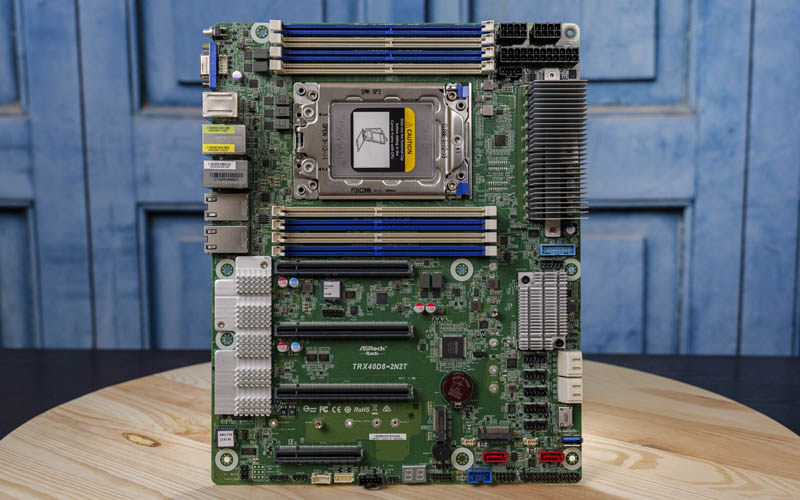
An example that one will immediately find when trying to install this motherboard is the ATX mounting pattern. Normally, one would find three mounting holes along the top side of the motherboard. ASRock Rack is using this space for DIMMs which means that one will likely have to uninstall a chassis motherboard standoff to get this motherboard to fit. That is an extremely important installation step so we wanted to ensure our readers are aware of it. Also in the top corner, we have the ATX and dual 8-pin CPU power supply inputs. ASRock Rack did a good job of fitting them somewhere where they will work for airflow, but this is a tight spot when cabled.
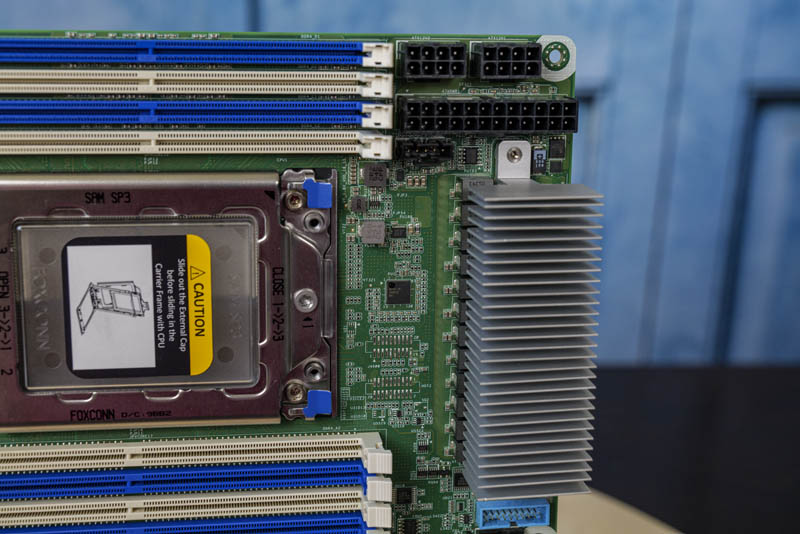
As for the centerpiece that is clearly the AMD TR4+ socket. This supports the third generation of AMD Ryzen Threadripper chips even up to the AMD Ryzen Threadripper 3990X.
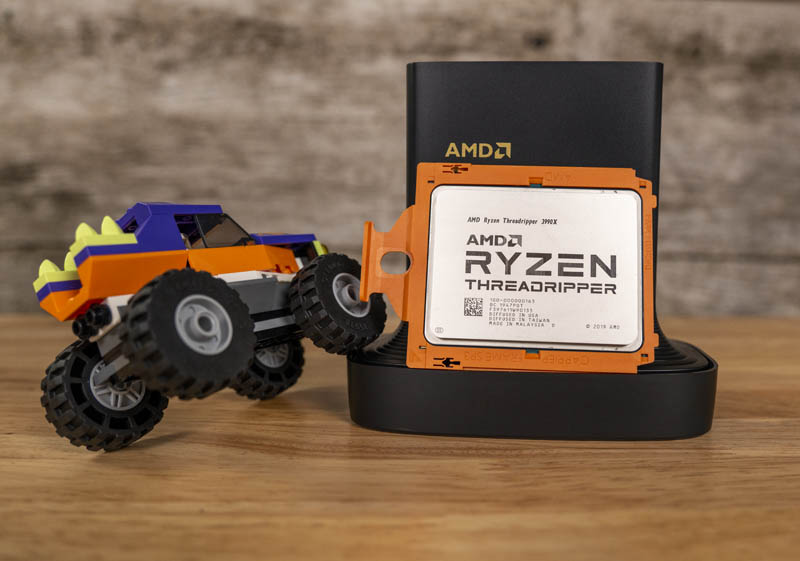
As such, we get four-channel DDR4-3200 as standard but ASRock Rack supports overclocking up to DDR4-4666. Maximum memory is up to 8x 32GB unbuffered DIMMs. Be advised, this system only supports unbuffered memory, not RDIMMs as we would find in the AMD EPYC 7002 Series. The four-channel memory is a hard limit of the platform and that is different than the lower-end AMD EPYC 7002 Rome CPUs with Half Memory Bandwidth.
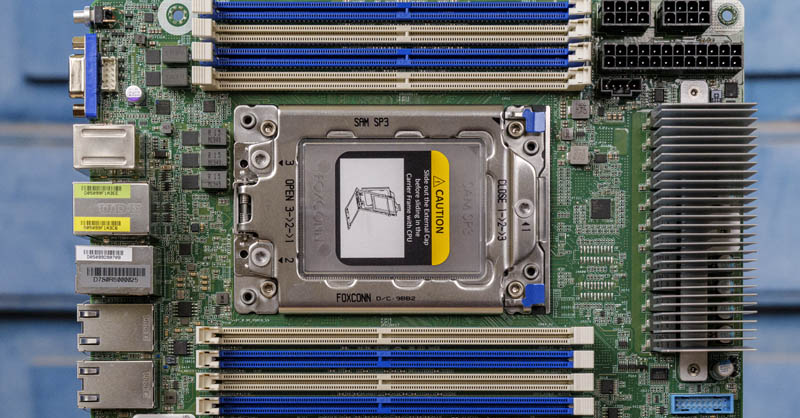
For someone coming from the consumer side of the computing spectrum, cooling a 280W CPU in a traditional motherboard may not seem that difficult. For the server-side, airflow is a big deal. Normally this requires a fairly large heatsink/ fan unit. For our testing, we ended up using one of the liquid coolers we had from our Threadripper testing, but we also have a project coming using this motherboard and a passive cooler. Stay tuned over the next few weeks for that build at STH.
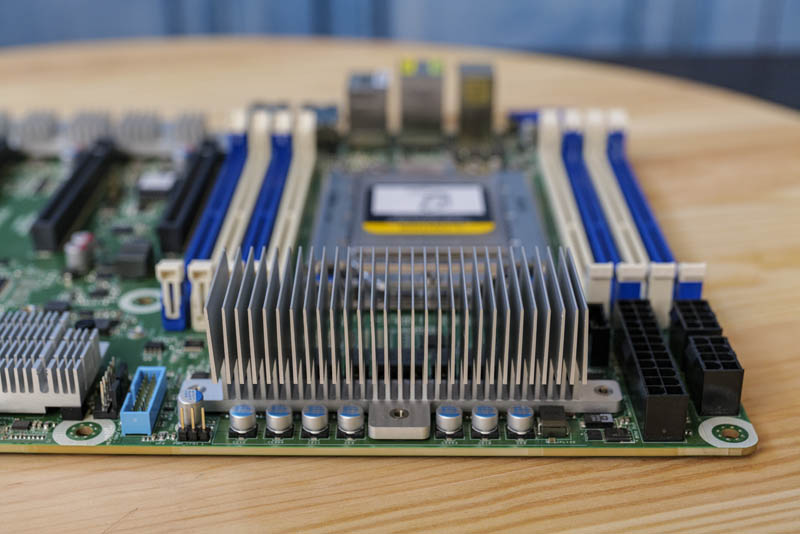
Two other notes on cooling, the airflow is a traditional server front to back design. This helps add more PCB space for PCIe which is great. It also means that in most workstation chassis this is a different orientation. For the server market, this is the orientation we want. For anyone thinking of using a large air cooler in a 4U/5U chassis with this motherboard, you also need to double-check DRAM clearance since the DIMM slots are close to the CPU socket. There are a number of heatsinks on this motherboard. They are designed to run with airflow over them. Even if you are using a liquid cooler, you need chassis fans to provide airflow over the heatsinks.
On that PCB space for PCIe connectivity, we can see the benefit by looking at the bottom half of the motherboard. Here we have three dual-slot PCIe Gen4 x16 slots that are each double-width. There is also an x8 slot at the bottom of the motherboard. This is an absolutely awesome design for those who want to use double-slot width PCIe Gen4 expansion devices. This is something many larger consumer motherboards are not able to accomplish due to their top to bottom socket and DIMM orientation.
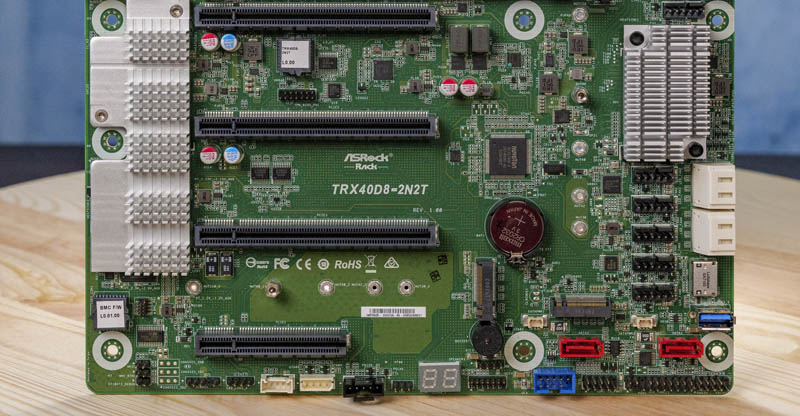
The PCIe expansion does not stop there. For example, we have two M.2 slots. These are PCIe x4 slots. A nice feature with these slots is that they support up to M.2 22110 (110mm) NVMe SSDs. We wish that ASRock Rack can update their M.2 designs to use tool-less retention rather than a standoff and screw mounting method as it makes servicing slightly easier. We can also see the six 6-pin (4-pin PWM compatible) fan headers to drive chassis cooling.
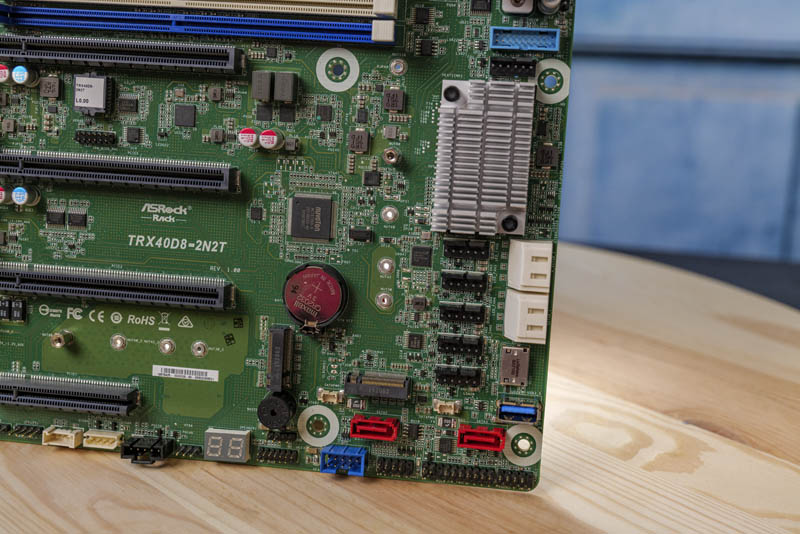
On the edge of the motherboard, we can see a USB 3.2 Gen1 Type-A header and a front panel connector on the other side of the chipset heatsink. Next to that is an Oculink port. This is listed as an optional component, but the sample ASRock Rack sent us has it. Next to that are four white SATA III connectors along with the two red connectors you can see in the photos. These are actually three different sets of functionality. The red ports are AMD TRX40 chipset SATA ports that support SATADOM power and have power connector headers next to them. On the white SATA header block, the left ports below are standard TRX40 ports.
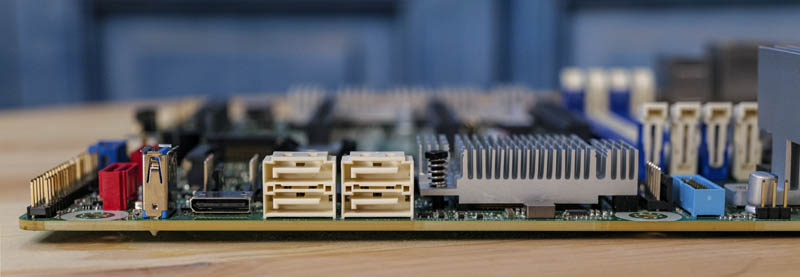
The right two ports are ASMedia 1061 ports. The ASMedia controller provides additional RAID 1/0 capabilities for those who do not want to use TRX40 chipset RAID. We wish that in the future ASRock changes the connector color of the ASMedia ports. Given the connector colors, this is where we can see a technician 12-18 months down the line doing a field upgrade and not understanding why two drives plugged into two of the white ports cannot be put into RAID. The reason is that they are on different controllers, so that is an area we think can be made more visually clear.
Moving to the rear I/O we get legacy I/O including a VGA port and even a PS/2 port. There are also two USB 3.2 Gen1 ports. Something that is quite unique is that we get two USB 3.2 Gen2 10Gbps ports. One is a Type-A and one is Type-C just below the IPMI management port.
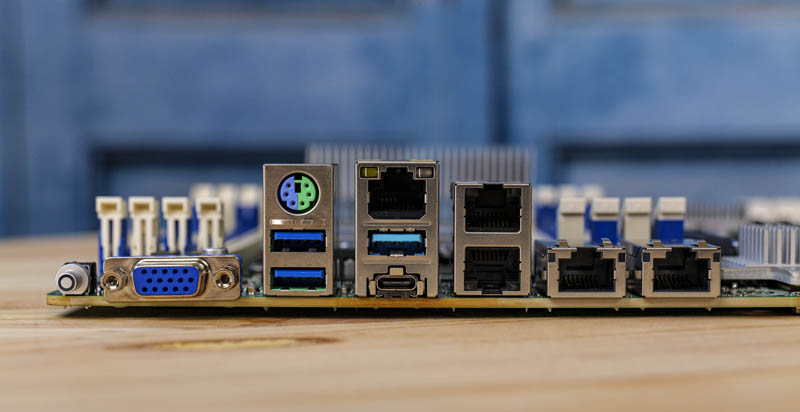
Networking is another unique feature. While one may expect a web hosting platform to have simple 1GbE onboard, ASRock Rack offers a massive upgrade. First, there are two 2.5GbE ports via an Intel i255 controller. Second, there are two 10Gbase-T ports via an Intel X710 NIC. The Intel i225 is a relatively newer controller, so you may need to check your OS support for this. Over time, the i225 will become very standard as a replacement for the i210 1GbE NIC, so we expect it to be very well supported in the future. The Intel X710 is a high-end 10GbE solution based on Intel’s higher-end networking chips. This is an upgrade over the Marvell-Aquantia and even the X540 solutions found on many other workstation and server motherboards. The X(L)700 series controllers have had a lot of time for their drivers to mature and be adopted by OS vendors so support is great these days. As a fun aside, that gives an aggregate of 25Gbps of network bandwidth for the platform.
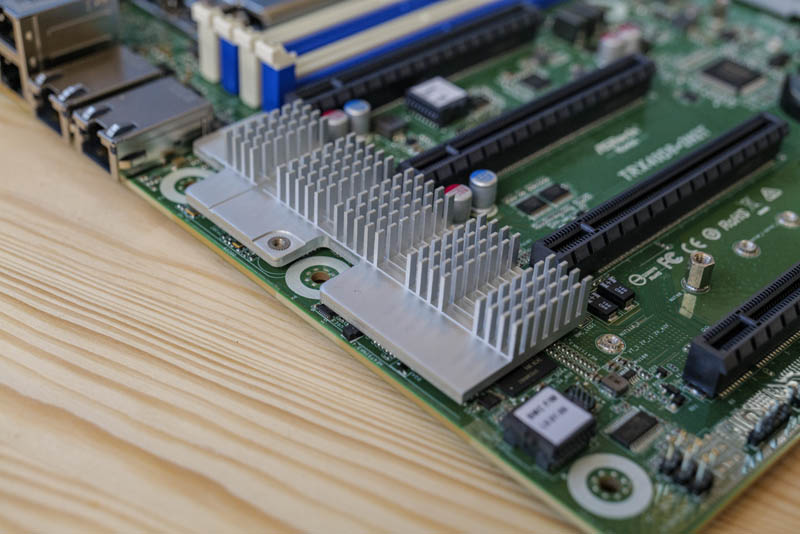
When one first looks at the TRX40D8-2N2T it looks like a standard ATX design. When we got into the details of the motherboard, we saw just how many small details ASRock Rack had to change to make this motherboard work. We also were pleasantly shocked at features such as the addition of 2.5GbE plus 10GbE networking in this system.
Next, we are going to look at the management and test configuration before getting to our performance and final words.

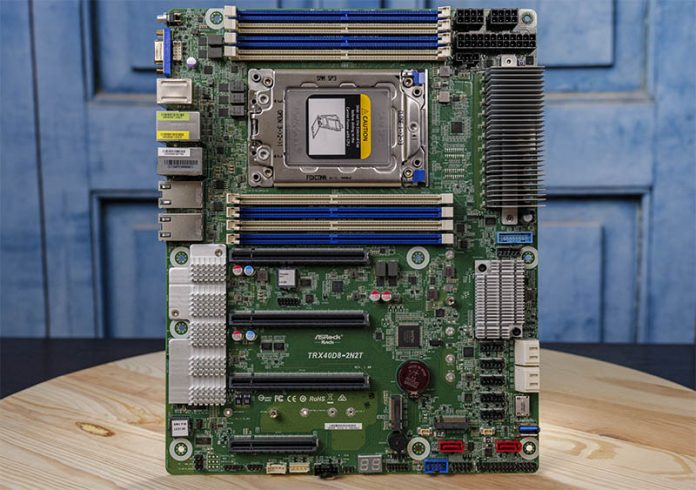



This motherboard would work also a workstation ? (with Windows sleeps and standby)
Good review.
“just” only 4 PCIe slots is a bit disappointing. Their previous model X399D8A-2T had 6 slots. NICs i255 + X710 is interesting.
Too bad AMD and Intel keep sticking to UDIMM.
It’s stupidly expensive memory, even on the second hand market.
Looks like a nice board though. Hope to one day consolidate my home servers to one box, but that will be RDIMMs for which CPU’s are very expensive.
weust, Intel is not sticking to UDIMM solely. Only their lowest Xeons are there (W-12xx). Once you get to W-22xx, you use (L)RDIMMs. The question is if you like to purchase slower CPU than competition and yet for way much more money. It’s basically RAM vs. cores/speed decision. Ignoring security bugs…
KarelG, security bugs is why I wouldn’t want Intel for now.
Sadly the Epyc CPU’s are too expensive for home use, afaik. I mean, I haven’t really looked but from what I’ve seen so far even the low core models are very expensive.
Right now my setup works, even though it mainly is Intel, so there is no need. Just a want.
With Threadripper Pro available Threadripper NON Pro needs to go back to its HEDT roost and stay there with its 4 memory channels and 64 PCIe 4.0 lanes. Threadripper Pro is the real workstation SKU and 8 memory channels and 128 PCIe 4.0 lanes and support for RDIMMs/Other ECC memory. Threadripper Pro is 2TB of memory support while Consumer Threadripper is only 256MB of memory capacity limited.
If one is using a lot of expensive ECC memory then having 8 memory channels and the possibility of 16 DIMM slots, at 2 DIMM slots per channel, presents a load more memory population options where one can purchase more of the lower cost/lower capacity ECC DIMMs and populate the MB with a larger amount of memory that way.
Used ECC Reg RAMs are way cheaper than ECC Unbuf RAMs and EPYC was sold at cheap price by HPE upgrade parts, so I choose EPYC over Threadripper for price.
https://forums.servethehome.com/index.php?threads/amd-epyc-rome-cpu-via-hpe-upgrade-very-cheap.26877/
“.. we also have a project coming using this motherboard and a passive cooler”; hopefully the project will use a cooler that will fit within a server chassis.
For 1/2 U chassis we will be trying the Dynatron L18 AIO CPU Cooler, it’s rated for the 3rd gen Threadrippers, so will be interesting to see how it handles our 3D rendering
Bought this board with a 3960X. System: four 32gb dimms, one ssd, five fans, no discrete video card.
Idle: 95W
Maximum observed power draw (prime95 blend): 311/314W, using two different power meters, one of which is a Fluke.
I dunno how you got 442W.. May you investigate a bit about that?
How many SATA drives will the BIOS correctly enumerate? Sadly, I have found that MB manufacturers fail to publish this parameter which is crucial in some server configurations. For example, 20 is a typical number, and that may be insufficient for a storage server.
I just bought this board and am having trouble enabling XMP. After enabling the system won’t POST and I have to clear CMOS to get it back. The XMP profile for this RAM is 3600mhz and 1.35v. Has anyone tried enabling XMP on this board? I reached out to Asrock just now. I’ll probably hear back from them tomorrow.